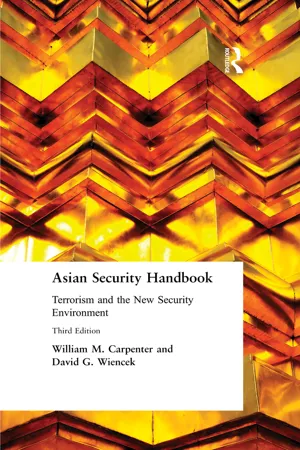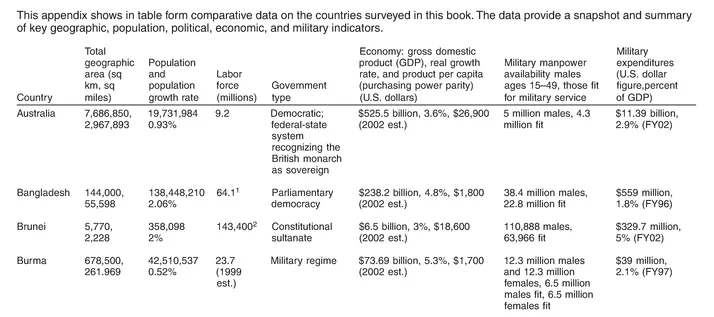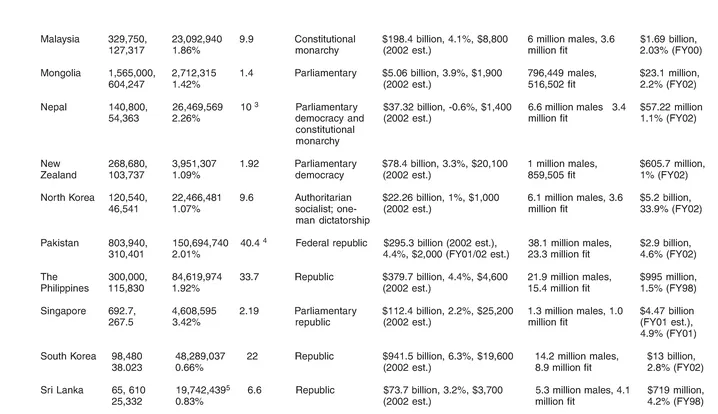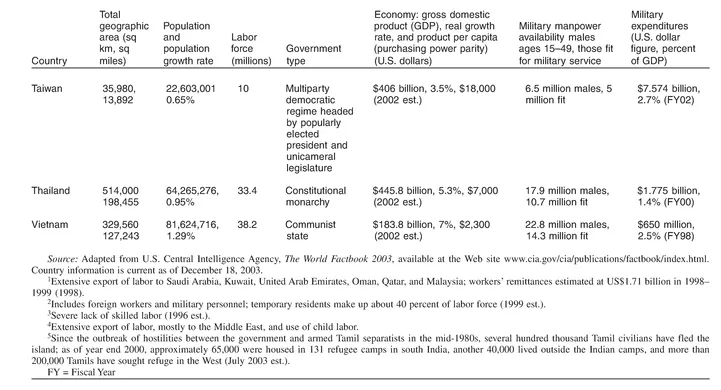
eBook - ePub
Asian Security Handbook
Terrorism and the New Security Environment
- 376 pages
- English
- ePUB (mobile friendly)
- Available on iOS & Android
eBook - ePub
Asian Security Handbook
Terrorism and the New Security Environment
About this book
This thoroughly revised and updated edition of Asian Security Handbook focuses on the new challenges to security in the Asia-Pacific region presented by international terrorism. It reviews old security realities covered in previous editions, and highlights more recent security issues in the region, including the North Korean threat, weapons of mass destruction proliferation, the South China Sea dispute, and the future U.S.-China rivalry. Featuring contributions by a distinguished group of international security and Asia experts, this new edition has been reformatted and restructured. A new introductory chapter on terrorism sets the stage for the country-by-country profiles and assessments of the political-security situations in twenty-three individual nations. A new appendix on foreign terrorist organizations is also included.
Frequently asked questions
Yes, you can cancel anytime from the Subscription tab in your account settings on the Perlego website. Your subscription will stay active until the end of your current billing period. Learn how to cancel your subscription.
At the moment all of our mobile-responsive ePub books are available to download via the app. Most of our PDFs are also available to download and we're working on making the final remaining ones downloadable now. Learn more here.
Perlego offers two plans: Essential and Complete
- Essential is ideal for learners and professionals who enjoy exploring a wide range of subjects. Access the Essential Library with 800,000+ trusted titles and best-sellers across business, personal growth, and the humanities. Includes unlimited reading time and Standard Read Aloud voice.
- Complete: Perfect for advanced learners and researchers needing full, unrestricted access. Unlock 1.4M+ books across hundreds of subjects, including academic and specialized titles. The Complete Plan also includes advanced features like Premium Read Aloud and Research Assistant.
We are an online textbook subscription service, where you can get access to an entire online library for less than the price of a single book per month. With over 1 million books across 1000+ topics, we’ve got you covered! Learn more here.
Look out for the read-aloud symbol on your next book to see if you can listen to it. The read-aloud tool reads text aloud for you, highlighting the text as it is being read. You can pause it, speed it up and slow it down. Learn more here.
Yes! You can use the Perlego app on both iOS or Android devices to read anytime, anywhere — even offline. Perfect for commutes or when you’re on the go.
Please note we cannot support devices running on iOS 13 and Android 7 or earlier. Learn more about using the app.
Please note we cannot support devices running on iOS 13 and Android 7 or earlier. Learn more about using the app.
Yes, you can access Asian Security Handbook by William M. Carpenter,David G. Wiencek,James R. Lilley in PDF and/or ePUB format, as well as other popular books in Betriebswirtschaft & Landeskunde. We have over one million books available in our catalogue for you to explore.
Information
Topic
BetriebswirtschaftSubtopic
LandeskundeAppendix 1
Comparative Country Data




Appendix 2
Foreign Terrorist Organizations (FTOs) in Asia
Throughout the text, mention is made of Foreign Terrorist Organizations or FTOs. As of 2004, the United States government (through the secretary of state) had designated thirty-seven terrorist groups worldwide as FTOs, pursuant to section 219 of the Immigration and Nationality Act, as amended by the Antiterrorism and Effective Death Penalty Act of 1996. The designations carry the following specific legal consequences:
- It is unlawful to provide funds or other material support to a designated FTO.
- Representatives and certain members of a designated FTO can be denied visas or excluded from theUnited States.
- U.S. financial institutions must block funds of designated FTOs and their agents and must report the blockage to the U.S. Department of the Treasury.
Of the thirty-seven designated FTOs, we present an abbreviated list of eleven below (by country) whose prime areas of operations are in Asia. Two of these eleven (al Qaeda and Jemmah Islamiyah) are transnational groups operating across the region.
This list and the group descriptions that follow are derived from the U.S. Department of State, Patterns of Global Terrorism 2002 and Patterns of Global Terrorism 2003, released by the Office of the Coordinator for Counterterrorism, April 30, 2003, and April 29, 2004, at www.state.gov.
Transnational
- al Qaeda
- Jemaah Islamiyah (JI)
Japan
- Aum Supreme Truth (Aum), aka Aum Shinrikyo, Aleph
Pakistan
- 4. Harakat ul-Mujahidin (HUM) (Movement of Holy Warriors)
- 5. Jaish-e-Mohammed (JEM) (Army of Mohammed)
- 6. Lashkar-e-Tayyiba (LT) (Army of the Pure or Army of the Righteous)
- 7. Lashkar I Jhangvi (LJ) (Army of Jhangvi)
Philippines
- 8. Abu Sayyaf Group (ASG)
- 9. Communist Party of Philippines/New People's Army (CPP/NPA)
Sri Lanka
- 10. Liberation Tigers of Tamil Eelam (LTTE)
Uzbekistan
- 11. Islamic Movement of Uzbekistan (IMU)
Group Descriptions
1. al Qaeda (Al-Qaida, aka Qa'idat al-Jihad)
Al Qaeda was established by Osama bin Ladin in the late 1980s to bring together Arabs who fought in Afghanistan against the Soviet Union. Helped finance, recruit, transport, and train Sunni Islamic extremists for the Afghan resistance. Current goal is to establish a pan-Islamic caliphate throughout the world by working with allied Islamic extremist groups to overthrow regimes it deems "non-Islamic" and expelling Westerners and non-Muslims from Muslim countries—particularly Saudi Arabia. Issued a statement under the banner of the World Islamic Front for Jihad Against the Jews and Crusaders in February 1998, saying it was the duty of all Muslims to kill U.S. citizens—civilian or military—and their allies everywhere. Merged with Egyptian Islamic Jihad (Al-Jihad) in June 2001. First designated in October 1999.
Activities
In 2003 al Qaeda carried out the assault and bombing on May 12 of three expatriate housing complexes in Riyadh, Saudi Arabia, that killed 20 and injured 139. Assisted in carrying out bombings on May 16 in Casablanca, Morocco, of a Jewish center, restaurant, nightclub, and hotel that killed 41 and injured 101. Probably supported the bombing of the J.W. Marriott Hotel in Jakarta, Indonesia, on August 5. Responsible for the assault and bombing on November 9 of a housing complex in Riyadh, Saudi Arabia, that killed 17 and injured 100. Conducted the bombings of two synagogues in Istanbul, Turkey, on November 15 that killed 23 and injured 200, and the bombings in Istanbul of the British consulate and HSBC Bank on November 20 that resulted in 27 dead and 455 injured. Has been involved in some attacks in Afghanistan and Iraq.
In 2002 al Qaeda carried out bombing on November 28 of a hotel in Mombasa, Kenya, killing 15 and injuring 40. Probably supported a nightclub bombing in Bali, Indonesia, on October 12 that killed about 180. Responsible for an attack on U.S. military personnel in Kuwait, on October 8, that killed 1 U.S. soldier and injured another. Directed a suicide attack on the MV Limburg off the coast of Yemen, on October 6 that killed 1 and injured 4. Carried out a firebombing of a synagogue in Tunisia on April 11 that killed 19 and injured 22.
On September 11, 2001, 19 al Qaeda suicide attackers hijacked and crashed 4 U.S. commercial jets—two into the World Trade Center in New York City, one into the Pentagon near Washington, DC, and a fourth into a field in Shanksville, Pennsylvania, leaving about 3,000 individuals dead or missing.
Directed the attack on the USS Cole in the port of Aden, Yemen, on October 12, 2000, killing 17 U.S. Navy members and injuring another 39. Al Qaeda conducted bombings in August 1998 of U.S. embassies in Nairobi, Kenya, and Dar es Salaam, Tanzania, that killed at least 301 individuals and injured more than 5,000 others. Claims to have shot down U.S. helicopters and killed U.S. servicemen in Somalia in 1993 and to have conducted 3 bombings that targeted U.S. troops in Aden, Yemen, in December 1992.
Al Qaeda is linked to the following plans that were disrupted or not carried out: to assassinate Pope John Paul II during his visit to Manila in late 1994, to kill President Clinton during a visit to the Philippines in early 1995, to bomb in midair a dozen U.S. transpacific flights in 1995, and to set off a bomb at Los Angeles International Airport in 1999. Also plotted to carry out terrorist operations against U.S. and Israeli tourists visiting Jordan for millennial celebrations in late 1999. (Jordanian authorities thwarted the planned attacks and put 28 suspects on trial.) In December 2001 suspected al Qaeda associate Richard Colvin Reid attempted to ignite a shoe bomb on a transatlantic flight from Paris to Miami. Attempted to shoot down an Israeli chartered plane with a surface-to-air missile as it departed the Mombasa airport in November 2002.
Strength
Al Qaeda probably has several thousand members and associates. The arrests of senior-level al Qaeda operatives have interrupted some terrorist plots. It also serves as a focal point or umbrella organization for a worldwide network that includes many Sunni Islamic extremist groups, some members of al-Gama'a al-Islamiyya, the Islamic Movement of Uzbekistan, and the Harakat ul-Mujahidin.
Location/Area of Operation
Al Qaeda has cells worldwide and is reinforced by its ties to Sunni extremist networks. Was based in Afghanistan until coalition forces removed the Taliban from power in late 2001. Al Qaeda has dispersed in small groups across South Asia, Southeast Asia, and the Middle East and probably will attempt to carry out future attacks against U.S. interests.
External Aid
Al Qaeda maintains moneymaking front businesses, solicits donations from like-minded supporters, and illicitly siphons funds from donations to Muslim charitable organizations. U.S. and international efforts to block al Qaeda funding has hampered the group's ability to obtain money.
2. Jemaah Islamiyah (JI)
Description
Jemaah Islamiyah is a Southeast Asian-based terrorist network with links to al Qaeda. The network recruited and trained extremists in the late 1990s, following the stated goal of creating an Islamic state comprising Brunei, Indonesia, Malaysia, Singapore, the southern Philippines, and southern Thailand. First designated as an FTO in October 2002.
Activities
JI was responsible for the bombing of the J.W. Marriott Hotel in Jakarta on August 5, 2003, the Bali bombings on October 12, 2002, and an attack against the Philippine ambassador to Indonesia in August 2000. The Bali plot, which left more than two hundred dead, was reportedly the final outcome of meetings in early 2002 in Thailand, where attacks against Singapore and soft targets such as tourist spots in the region were also considered. In December 2001 Singapore authorities uncovered a JI plot to attack the U.S. and Israeli embassies and British and Australian diplomatic buildings in Singapore, and in June 2003, Thai authorities disrupted a JI plan to attack several Western embassies and tourist sites there. Investigations also linked the JI to bombings in December 2000 where dozens of bombs were detonated in Indonesia and the Philippines, killing twenty-two in the Philippines and fifteen in Indonesia.
The capture in August of Indonesian Riduan Isamuddin (aka Hambali), JI leader and al Qaeda Southeast Asia operations chief, damaged the JI, but the group maintains its ability to target Western interests in the region and to recruit new members through a network of radical Islamic schools based primarily in Indonesia.
Strength
Exact numbers are currently unknown, and Southeast Asian authorities continue to uncover and arrest additional JI elements. Elements of total JI members vary widely from the hundreds to the thousands.
Location/Area of Operation
JI is believed to have cells spanning Indonesia, Malaysia, the Philippines, southern Thailand, and Pakistan and may have some presence in neighboring countries.
External Aid
Investigations indicate that, in addition to raising its own fun...
Table of contents
- Cover
- Title
- Copyright
- Contents
- Foreword
- Editors’ Note
- List of Illustrative Materials
- Introduction Terrorism and the New Security Environment
- Country Profiles
- Glossary of Abbreviations and Acronyms
- Appendix 1: Comparative Country Data
- Appendix 2: Foreign Terrorist Organizations (FTOs) in Asia
- About the Editors and Contributors
- Index